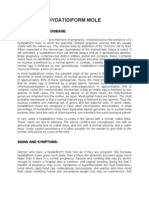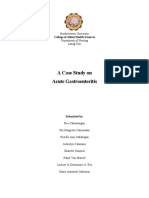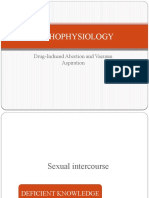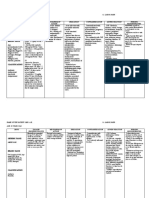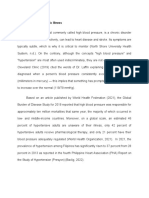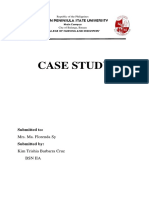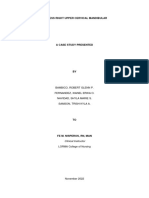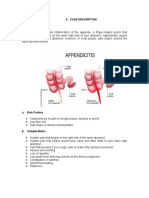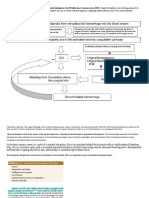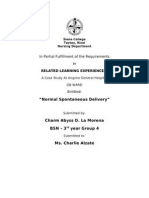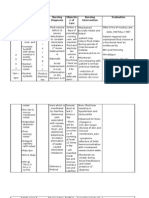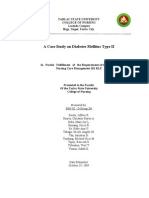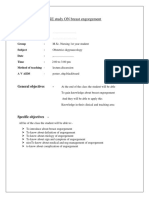Acute Pyelonephritis
Acute Pyelonephritis
Uploaded by
Christine Karen Ang SuarezCopyright:
Available Formats
Acute Pyelonephritis
Acute Pyelonephritis
Uploaded by
Christine Karen Ang SuarezCopyright
Available Formats
Share this document
Did you find this document useful?
Is this content inappropriate?
Copyright:
Available Formats
Acute Pyelonephritis
Acute Pyelonephritis
Uploaded by
Christine Karen Ang SuarezCopyright:
Available Formats
TARLAC STATE UNIVERSITY
COLLEGE OF NURSING
Lucinda Campus Brgy. Ungot, Tarlac City
A Case Study on Acute Pyelonephritis
In Partial Fulfillment of the Requirements of the Subject Nursing Care Management 102 RLE
Presented to the Faculty Of the Tarlac State University College of Nursing Presented by: BSN III - C Group C4 Querido, Richen Raiz, Jayscent Rodriguez II, Rolando Sabat, Aprillyn Santos, Marivic Santos, Willa Milafrosa Sotelo, Jeffrey Suarez, Christine Karen Sumang, Jerico Sumaoang, Maria Luisa Date Submitted: December 5, 2009
INTRODUCTION
One of the most common renal diseases, acute pyelonephritis (also known as acute infective tubulointerstitial nephritis) is a sudden inflammation caused by bacteria that primarily affects the interstitial area and the renal pelvis or, less often, the renal tubules. (Handbook of Diseases, 3rd Edition by Springhouse) Acute pyelonephritis is most common in adult females but can affect people of either sex and any age. Its onset is usually sudden, with symptoms that often are mistaken as the results of straining the lower back. Pyelonephritis often is complicated by systemic infection. Left untreated or unresolved, it can progress to a chronic condition that lasts for months or years, leading to scarring and possible loss of kidney function. Acute pyelonephritis results from bacterial infection of the kidneys. Infecting bacteria usually are normal intestinal and fecal flora that grow readily in urine. The most common causative organism is Escherichia coli, but Proteus, Pseudomonas, Staphylococcus aureus, and Streptococcus faecalis may also cause such infections. (Handbook of Diseases, 3rd Edition by Springhouse) Typically, the infection spreads from the bladder to the ureters, then to the kidneys, as in vesicoureteral reflux. Vesicoureteral reflux may result from congenital weakness at the junction of the ureter and the bladder. Bacteria refluxed to intrarenal tissues may create colonies of infection within 24 to 48 hours. Infection may also result from instrumentation (such as catheterization, cystoscopy, or urologic surgery), from a hematogenic infection (as in septicemia or endocarditis) or, possibly, from lymphatic infection. (Handbook of Diseases, 3rd Edition by Springhouse) Pyelonephritis may also result from an inability to empty the bladder (for example, in patients with neurogenic bladder), urinary stasis, or urinary obstruction due to tumors, strictures, or benign prostatic hyperplasia. (Handbook of Diseases, 3rd Edition by Springhouse) Approximately 250,000 cases of acute pyelonephritis occur each year, resulting in more than 100,000 hospitalizations.3 Women are approximately five times more likely than men to be hospitalized with this condition (11.7 versus 2.4 hospitalizations per 10,000 cases, respectively); however, women have a lower mortality rate than men (7.3 versus 16.5 deaths per 1,000 cases, respectively).4 Acute pyelonephritis occurs in 1 to 2 percent of pregnant women, increasing the risk for premature labor and low-birth-weight infants. (Diagnosis and Management of Acute Pyelonephritis in Adults, Kalyanakrishnan Ramakrishnan, M.D., and Dewey C. Scheid, M.D., M.P.H.)
OBJECTIVES OF THE CASE STUDY NURSE-CENTERED General: This study is aim to gain or broaden the knowledge and skills with regards to the disease condition acute cystitis. Specific: 1. To gain more knowledge about acute cystitis, its epidemiology,
contributing factors, pathophysiology, clinical manifestations, and the treatment required 2. To enhance the student skills by performing various nursing interventions to solve or alleviate the patients needs as implementations of the formulated plans of care 3. 4. 5. To promote the students wellness of social health by conducting a healthy The nurse should be able to impart knowledge to the patient and To gain fulfillment during and after rendering care to the patient, thus social interaction with the patient significant others regarding the patients condition uplifting their emotional health PATIENT-CENTERED General: To educate the client about her current condition and render nursing interventions that will respond to her needs Specific:
1.
To increase the clients knowledge about her disease, which is acute
cystitis by means of giving health teachings in the contributing factors, disease course, manifestations and treatments involved 2. 3. To address the patients needs and problems that accompany the disease To promote her emotional well-being by encouraging her to speak of by performing appropriate nursing interventions based on health care plans whatever she feels about her disease condition 4. The client should be able to gain knowledge about her condition and the different ways on how to understand and accept her state of being. Reasons in choosing the Case Study Our group chose this case study to gain knowledge about the disease. The group wants to know more about the disease, its treatment, and the proper nursing management for patients with this kind of disease. The case will help the group in dealing with patient with the same condition. Our curiosity leads us to choosing the disease condition to study. Promotion of health, prevention of diseases and illnesses, rehabilitation and restoration of good health are important in doing the case. In the accomplishment of case study, the group will be able to know and develop more fully our skills in assessment, planning, nursing care plans, implementation/interventions and evaluation.
Importance of the Study The case study is important because it would further help us in dealing with patient with the same condition and of course be competitive enough to provide the nursing management entitled for the needs of our patient. It provides broader comprehension about the condition chosen through research and actual observation as it serves as training and practice in developing learned skills in the assessment and management of the said disease. Through this case study, a holistic approach in assessing the patients health will be delivered where it can be immediately attended to and given proper interventions. It serves as a way to familiarize the students with the different medical approaches toward the ongoing curative phase.
This study serves as a tool for upcoming nursing students of the school. And this is also for other nursing colleagues for them to understand the dynamics of diabetes mellitus type II as to the book-based management and actual clinical interventions. Furthermore, this study may be used as a spring board for a more advanced and in depth study that is in accordance to changing and developing society.
NURSING PROCESS Assessment A. Demographic data Name: Sex: Age: Civil Status: Birth date: Place of Birth: Chief complaint: Mrs. Clover Female 51-years old Married Sept. 15, 1958 Tarlac city Dysuria and hematuria, with nausea and vomiting
Diagnosis: Nationality: Role in the Family: Religion:
Acute Pyelonephritis Filipino Mother Roman catholic
Health Care Financing:
Philhealth RHU/Gov. Hospital
Usual Source of Medical Care: B. Environmental Status
Mrs. Clovers house is made up of cement and wood. It composes of two bedrooms, small kitchen, one living room and one toilet room. She stated that there is presence of threats that could cause injury to them. Their house is located near the road and surrounded by near house. Trees were planted at their yard according to the patient. They also have domestic animals like dogs in their house. They get their water from a water pump near their house. Their toilet is located at the back of their house C. Lifestyle Mrs. Clover is regularly doing the household chores and it serves as her daily exercise. After doing all household chores, she spends her time chatting with her neighbours and then goes to sleep during siesta time. Another past time activity that she is fond of is watching television. She usually sleeps at around 9:00 pm and wakes up at around 6:00 am, but because of frequent urination she has sleep deprivation. D. History of past illness Mrs. Clover suffers from UTI for one year. She experienced pain and burning sensation during urination. She has no history of serious hospitalization and injuries except when she gave birth to her last child two months ago. She mentioned that she had chicken pox and some minor injuries in her school-age years. She has no known allergies to food, medications, animals, dust, etc. Patient also said that she received immunizations but she cannot remember what vaccines she received. She usually feels headache and dizziness. Some medications she took are paracetamol, and other OTC medicines for cough, colds and headache.
E.
History of Present illness A year prior to hospitalization, Mrs. Clover experienced difficulty
urinating and then consult doctor about what she experienced. The doctor told her that she has urinary tract infection. During those times that she felt symptoms of UTI like fever and chills, nausea and vomiting, back pain she just stay in her bed and rest for a while. Two days prior to consultation, condition persisted accompanied by dizziness and excessive pain during urination, with foul smell. She also noticed blood tinged when urinating. An hour prior to consultation, Mrs. Clover suddenly felt flank pain accompanied by body weakness and is unable to stand alone hence decided to consult her doctor, she was rushed to Tarlac Provincial Hospital. She was given IFV and undergone laboratory exam to rule out the disease she has.
13 Areas of Assessment 2009
November19,
A.
Social Status Mrs. Clover is the one whose is responsible in managing their house. She
does the household chores and taking care of her children. According to her, she had a good relationship with her family and relatives as well to her neighbors. She lives together with her husband and two children. The family maintains a good relationship with each other. According to her they express their love and concern within the family by helping each other when they have their problem and doing the household chores together. NORMS:
The ability to interact successfully with people and within the environment of which each person is a part, to develop and maintain intimacy with significant others, and to develop respect and tolerance for those with different opinion and beliefs. (Kozier B. 2004, Fundamentals of Nursing Concepts, Process and Practice Seventh Edition p.172) Families consist of persons and their responsibilities within the family. A family structure of parents and their offspring is known as the nuclear family (Kozier B. 2004, Fundamentals of Nursing Concepts, Process and Practice Seventh Edition p.191) The ability to achieve balance between work and leisure time. A persons belief about education, employment and home influence personal satisfaction and relationships with others (Kozier B. 2004, Fundamentals of Nursing Concepts, Process and Practice Seventh Edition p.173)
INTERPRETATION: The clients social status is in a well state as manifested by the client, having no problems in interacting with other persons especially in her family. She fulfills her part in the family and able to manage her time (doing the house hold chores, watching television, etc.) B. Mental status/Neurological Status During the assessment, the patient is oriented to time, date and place. By answering my question nay anung oras nyu po iniinum ang gamut nyung ceftriaxone? she response kada ikalabing dalawang oras. She gave accurate information and appropriate answers to the questions being asked. The patient exhibits good communication by demonstrating good eye to eye contact. NORMS: Consciousness: Being aware of ones own existence, feelings and thoughts and aware of the environment.
Language: Using the voice to communicate ones thoughts and feelings. Attention: The power of concentration, the ability to focus on one specific thing without being distracted. Memory: The ability to lay down information and store experience. (Carolyn Jarvis, Physical Examination & Health Assessment 3rd Edition)
INTERPRETATION: The patient is not demonstrating any signs of alteration in her mental status. She has normal cognition during the interview and able to answer accurately to the questions being asked to her.
C.
Emotional Status During interview, Mrs. Clover shown poor eye contact with facial tension
and restless. On the other hand during the interview Mrs. Clover expressed frustrations because she never thought that all the things that she have done were all wrong that leads her in having her condition. She admitted that she had fear of urinating with blood. But she manages to divert attention to other things.
NORMS: A person expresses themselves as optimistic and a positive thinker in life. There should no presence of fear, anxiety, grieving etc. The patient should have the ability to manage stress and to express emotions appropriately. It also involves the ability to recognize, accept, and express feelings and to accept ones
imitations. (Kozier, B. (2004). Fundamentals of Nursing: Concepts, Processes and Practice. Seventh edition)
INTERPRETATION: The client is able to express her optimistic perception in life even with some fear and anxiety.
Sensory Perception Sense of Sight Based on the assessment, Mrs. Clover has no alteration in sense of sight. We provide a newspaper to test her sense of sight she read the headlines correctly. Her eyes are symmetrical and round and sclera is white in colour.
NORMS Eyes symmetrically aligned, equal movement, eye bilaterally blinking, sclera appears white, skinny smooth conjunctiva no edema and tenderness on lacrimal gland. Eyes glasses are use to correct refractive disorders. Sense of Taste Mrs. Clover does not have any alteration in her taste, she can able to determine the foods taste as she mentioned that she can differentiate various taste such as sour, bitter, sweet and others with the foods that she eats. Her tongue is reddish and in normal position and can move freely.
NORMS: Tongue is reddish/pink in color, central in position, no lesions, raised papillae (taste buds), moves freely, no tenderness no palpable nodules. Tactile Sensitivity Upon examination, one of the group member pinched her right and left arm and ask her to tell the sensation. The patient responded and verbalized what she felt and stated that she felt pain when she was pinched. She complains with flank pain with the pain scale of 7/10 during the interview. NORMS: The skin contains receptors for pain, touch, pressure and temperature. Sensory signals that help determine precise locations on the skin are transmitted along rapid sensory pathways, and less distinct signals such as pressure or poorly localized touch are sent via slower or sensory pathways. (Health Assessment and Physical Examination, Mary Ellen Zator Estes 5th Edition) INTERPRETATION: The patients sensory transmission functions are within the normal as manifested by the data presented. D. Motor Stability Mrs. Clover is able to ambulate with assistance. She feels easy fatigability and weakness during minimal movements. NORMS: Normal muscle strength allows for complete voluntary range of joint motion against both gravity and moderate to full resistance. Muscle strength is equal bilaterally. A healthy person can perform the different Range of Motion (ROM). (Health Assessment and Physical Examination, Mary Ellen Zator Estes 5th Edition)
INTERPRETATION: She has slight alteration in his motor stability because of easy fatigability and weakness. E. Body Temperature Date and Time November 03:52 pm 19, 2009; Results 38.3 0C via axilla 38.0 0C via axilla 37.80C via axilla
November 20, 2009; 04:30 pm November 21, 2009; 03:45 pm NORMS:
The normal body temperature ranges from 36.5 to 37.5oC (Fundamentals of nursing Kozier 2004, 7th edition) INTERPRETATION: Based on the given norms the patients body temperature has alteration due to infection caused by her present condition
G. Respiratory Status Date and Time November19, 2009; 03:52 pm November20, 2009; 05:30 pm November21, 2009; 05:45 pm Results 19 cpm No retraction 17 cpm No retraction 16 cpm No retraction
NORMS: There should be an absence of retractions and bulging of the (Inter Coastal Spaces) ICS. In the resting adult, the normal respiratory rate is 12 to 20 breaths per minute.
INTERPRETATION:
Upon assessment Mrs. Clover showed normal respiratory status. H. Circulatory Status On assessment the patient exhibit good capillary refill after the Blanch Test by applying gentle pressure at the nail beds it return at 2 seconds. She had a blood pressure reading of 130/90 mmHg and pulse rate of 84bpm. (November19, 2009; 03:52 pm) Date and Time November19, 2009; 03:52 pm November20, 2009; 05:30 pm November21, 2009; 05:45 pm Result 120/90mmHg 130/80mmHg 130/90mmHg
Pulse rate
Date and Time November19, 2009; 03:52 pm November20, 2009; 05:30 pm November21, 2009; 05:45 pm
Result 84bpm 89bpm 95bpm
NORMS: Blanch test should return at 1 to 2 seconds and Normal blood pressure is 120/80 mmHg and the pulse rate is 60-100 bpm in adults. (Kozier, 2006) INTERPRETATION: Based on the data shown Mrs. clover blanch test is normal but her bp is slightly elevated because of her present condition I. Nutritional Status During our assessment Mrs. clover is thin in appearance her weight is 42kg(92 lbs)and her height is 5 feet. Her nutritional status she suffering from nutritional imbalance she eats 2-3 times a day. She usually takes 5-7 glasses of water daily. She usually eats vegetables and salty foods like junk foods and plenty of softdrinks. Computation Form ula of BMI EQUATI ON RESULT
BMI=WEIGHT IN KG HEIGHT IN M
BMI=42k g 2.322 6=18.08
UNDERWEI GHT
NORMS: Normal eating pattern is on the minimum of 3 5 times per day, depending upon metabolic need and demands. Fluid is on the average of 8-10 glasses (2-3 liters) per day.
Body Mass Index Interpretation (Javis, 2000) <18.5 ------------------------------ underweight 18.5 24.9 ----------------------- healthy 25.0 29.9 ----------------------- overweight 30> -------------------------------- obese
Food pyramid
(SOURCE: Physical Assessment and Health Examination 4th Edition, Carolyn Jarvis)
INTERPRETATION: Her BMI was interpreted as underweight (18.08). There is a problem in her eating habits and her fluid intake was in below normal. J. Elimination Status Upon assessment, the urine output of Mrs. Clover was in 38 ml around 2 hours. Slightly red in appearance and with pain during urination. Usually had a bowel movement of 1-2 times per day. Patient experienced frequent urination but in small amount. NORMS: Normal bowel movement is 1-3 times per day and voids at 1,200 1,500 mL per day or 30-60 ml the normal color of stool is brown and well formed the urine is clear and yellowish in color(health assessment and physical examination,3rd edition by Mary Ellen zastor estes).
INTERPRETATION: The client experience hematuria due to her condition. This is because of the inflammation of her kidney.
K.
Rest and Sleep Mrs. Clover stated that she only sleeps at 9:00 PM and wakes up at 6:00
AM. She usually sleeps 6-7 hours at night but has a disturbed sleeping pattern due to her present condition. And she usually has afternoon naps of about 15 minutes to an hour. NORMS: Older adults sleep about 6-8 hours of sleep at night (Kozier, 2004)
INTERPRETATION: The patient sleeps inadequately due to her disturbed sleeping patterns. She is not able to complete the normal sleep hours.
L.
Reproductive Status Mrs.clover had her first menarche when she was 16 years old her cycle
usually last for 5 days she experiences headache and pain on the pelvic area during her cycle she usually use 2 pads with fully soak blood The patient had 2 children, a boy and a girl, which were delivered normally.
Standard pilliterri)
menarche which is the first menstruation occur at an average age of
onset between 9 to 17 years old (maternal and child health nursing 4th edition by
INTERPRETATION: The patient had a normal reproductive system since she had her menarche at the right age
M.
State of Skin Appendages
Generalized color; Mrs. Clover had fair complexion Texture; there is no redness noted on the skin of Mrs. Clover Moisture; the skin is dry perspiration was absent to her Temperature; the patient skin was warm and dry. . NORMS: Normally, the skin is a uniform whitish pink or brown color, depending on the patients race. There are no areas of increased vascularity, ecchymosis, or bleeding. No skin lesions should be present except for freckles, birth marks or moles, which may be flat or elevated. The skin is dry with a slight perspiration present on the hands, axilla, face and in between the skin folds. Skin should normally feel smooth, even and firm except when there is significant hair growth. A certain amount of roughness can be normal, hair varies from dark black to pale blonde based on the amount of melanin present in light-skinned individuals and light brown in dark-skinned individuals. The nail surface should be smooth and slightly rounded and flat.
INTERPRETATION: Mrs. Clover skin and appendages status was not affected there is no presence of redness on her skin is warm to touch
ANATOMY AND PHYSIOLOGY
EXTERNAL ANATOMY KIDNEY They are paired that are reddish in color and resemble beans in shape. They are about size of a close fist located at retro peritoneally ( behind and outside peritoneal cavity) on the posterior wall of the abdomen from 12 thoracic vertebrae to the third lumbar vertebrae in adult. The average adult kidney weighs approximately 133-170g. (4.5 oz) and is 10-12 cm long 6 cm wide and 2.5 cm thick the right kidney is slight lower than the left due to the location of the liver. Kidney are well protected by the ribs and by the muscles of the abdomen and back3 LAYERS OF TISSUE SURROUNDING EACH KIDNEY 1.
RENAL CAPSULE - innermost layer, it is a smooth transparent fibrous connective tissue membrane that connects with the outermost covering of the ureter at the hilum. It serves as a barrier against infection and trauma to the kidney
2. ADIPOSE CAPSULEsecond layer it is a mass of fatty tissue that protects the kidney from blows. It firmly holds the kidney in the abdominal activity 3. RENAL CAPSULEouter most layer which consist of a thin of a layer of fibrous connective tissue that also anchors the kidney to their surrounding structures and to the abdominal wall
INTERNAL ANATOMY OF KIDNEY The renal parenchyma is divided into two parts the cortex and the medulla MEDULLA Medulla is approximately 5 cm wide which is the inner portion of the kidney. It contains the loop of Henle, the Vasa Recta and the collecting ducts of the juxtamedullary nephrons the collecting duct from both the juxtamedullary and the cortical nephrons connect to renal pyramids which are triangular and are situated with base facins the concave surface of the kidney and the point (papilla)facins the hilum/pelvis. Each kidney contains approximately 8-18 pyramids. The pyramids drain into 4 to 13 minor calices which drain into 2 major calices that open directly into the renal pelvis. The renal pelvis is the beginning of
the collecting system and is composed of structures that are designed to collect and transport urine. Once the urine leaves The renal pelvis, the composition of urine does not change. CORTEX- It is approximately 2 cm wide, is located farthest from the center of the kidney and around the outer most edges. It contains the nephrons. NEPHRONS-these are the functional units of kidney. It is microscopic renal tubule which functions as a filter. Each kidney has 1 million nephrons, which usually allows for adequate renal function even if the opposite kidney is damaged or becomes nonfunctional. The structures are located within the renal parenchymas that are responsible for initial formation of urine. 2 KINDS OF NEPHRONS a. Cortical nephrons this makes up 80 to 85 % of total number of nephrons in the kidney which are located in the innermost part of the cortex. b. Juxtamendullary nephrons which make up the remaining 15 to 20 % are located deeper in the cortex. There are distinguished by long loops of Henle, which are surrounded by long capillary loops called Vasa Recta that dip into Medulla of the Kidney. Nephrons are made up of two basic components; a filtering element component of an enclosed capillary network and the attach tubule. The glumerulus is a unique network of capillaries suspended between the afferent and efferent blood vessels, which are enclosed in an epithelial structure called Bowmans capsule. The glumerular membrane is composed of three filtering layers: (a) Capillary endothelium, (b) basement membrane, and (c) epithelium. This membrane normally allows filtration of fluid and small molecules yet limits passage of larger molecules, such as blood cells and albumin. The tubular component of the nephrons begins in the Bowmans capsule. The filtrate created in the Bowmans capsule travel first into the proximal tubule, then into loops of Henle, distal tubule, and either the cortical or medullary collecting ducts. The structural
arrangement of the tubule allows the distal tubule to lie in close proximity to where the afferent and efferent arteriole respectively enter and leave the glumerulus. The distal tubular cells located in this area, known as the Macula Densa which functions with the adjacent afferent arteriole and create what is known as juxtaglumerulus apparatus. This is the site of the renin production. Renin is a hormone directly involved in the control of arterial blood pressure; it is essential for proper functioning of the glumerulus. The tubular component consists of the Bowmans capsule, the proximal tubule, the descending and ascending limbs of the loop of Henle, and the cortical and medullary collecting ducts. This portion of the nephrons is responsible in making adjustments in the filtrate based on the bodys needs. Changes are continually made as the filtrate travels through the tubules until it enters the collecting system and is expended from the body.BLOOD SUPPLY TO THE KIDNEYThe hilum of pelvis is the concave portion of the kidney through which are renal artery enters and ureters and renal vein exit. The kidney received 20% to 25% of the total cardiac output, which means that all of the bodys blood circulates through the kidneys approximately 12 times per hour. The renal artery (arising from the abdominal aorta) divided into smaller and smaller vessels, eventually forming the afferent arterioles. Each afferent arterioles branch to form a glumerulus, which is the capillary bed responsible for glumerular filtration. CONCLUSION
Having series of research about acute pyelonephritis, its management and after completing the case study, the group had come out with the following conclusion:
Patients condition was enough proven by adequate data gathered Proper analysis was made so that nursing problems were formulated. Evaluated patients health situation through Community Duty by Home
health teaching like nursing interventions about diet, drugs. RECOMMENDATION
Having studied the condition of the patient, we come up with the following recommendation: Medication: Continue medications as prescribed Prescribed medication must be taken on time
Exercise: Strenuous exercise should be avoided Encouraged to take enough rest to regain strength
Treatment: Take home medications as doctors order Report unusual signs and symptoms
Health Teachings: Advised the client to have enough bed rest Upon discharge patient education should emphasize the importance of close follow up care Encourage to practice personal hygiene properly Void when there are urged to urinate Wipe from back to front to prevent bacteria around the anus from entering the vagina or urethra Diet: Diet as tolerated Increase fluid intake Advised the patient to eat vegetables, fruits rich in vitamin C and fiber rich foods.
VI. Bibliography
NANDA International.(2003). NANDA nursing diagnosis: Definitions and Classification 2003-2004.Philadelphia: Author
Rizzo,D.C.,(2006).Fundamentals of Anatomy and Physiology(2nd ed.)
Claudio,U.S.,et.al.(2004)Basic Nutrition for Filipinos(fifth edition)
Mosby,E.,(2006).Pocket Profesions(fifth Edition)
Dictionary
of
Medicine,
Nursing
and
Health
You might also like
- Toltec Body Healing EbookDocument204 pagesToltec Body Healing EbookDanielle Grace100% (4)
- Normal Spontaneous DeliveryDocument64 pagesNormal Spontaneous DeliveryMichellin Andres MarianoNo ratings yet
- Reflective EssayDocument2 pagesReflective EssayAnonymous 0CdrZVNo ratings yet
- Southern SayingsDocument11 pagesSouthern SayingssbodmannNo ratings yet
- Hydatidiform Mole - OverviewDocument4 pagesHydatidiform Mole - Overviewannmanalad9438No ratings yet
- Abruptio Placenta. Final OutputDocument15 pagesAbruptio Placenta. Final OutputCharles Loriaga Cruz IINo ratings yet
- Hyperbilirubinemia Case StudyDocument7 pagesHyperbilirubinemia Case Studyr_ramos0759No ratings yet
- Drug StudyDocument12 pagesDrug StudyIsha Catimbang GenerilloNo ratings yet
- What Is A Health Care Profession?: Chapter Iv: The Calling of The Health Care ProviderDocument14 pagesWhat Is A Health Care Profession?: Chapter Iv: The Calling of The Health Care ProviderNur SanaaniNo ratings yet
- Case Study - Incomplete Abortion Related To APSDocument8 pagesCase Study - Incomplete Abortion Related To APSRomeo ReyesNo ratings yet
- Case Pres AutosavedDocument21 pagesCase Pres AutosavedJaysellePuguonTabijeNo ratings yet
- 2016 Chronic Hypertension in PregnancyDocument13 pages2016 Chronic Hypertension in PregnancydkasisNo ratings yet
- Group 3 Abruptio Placentae Revised Case StudyDocument87 pagesGroup 3 Abruptio Placentae Revised Case StudyXena IngalNo ratings yet
- Case Presentation NCM 102Document30 pagesCase Presentation NCM 102Jubille FerrarenNo ratings yet
- Fabella NICUDocument4 pagesFabella NICURoel Dominic BasilanNo ratings yet
- Gordons 11 Functional PatternDocument3 pagesGordons 11 Functional PatternMaha AmilNo ratings yet
- Case (Acute Gastroenteritis) Group 4Document36 pagesCase (Acute Gastroenteritis) Group 4EljhayrosNo ratings yet
- CP - Acute PyelonephritisDocument44 pagesCP - Acute Pyelonephritiskenken the ExplorerNo ratings yet
- NCP Drug Study Group 1Document21 pagesNCP Drug Study Group 1Cassandra Grace Muerong Dela CruzNo ratings yet
- Evaluation of Fetal DeathDocument9 pagesEvaluation of Fetal DeathVinisia TakaraiNo ratings yet
- Pathophysiology: Drug-Induced Abortion and Vacuum AspirationDocument14 pagesPathophysiology: Drug-Induced Abortion and Vacuum AspirationMelvin M. AquinoNo ratings yet
- Final - Mrs. X - Case Study (Group 3-RR21)Document45 pagesFinal - Mrs. X - Case Study (Group 3-RR21)Gabriel Andrei C. RelayoNo ratings yet
- Bea-Case StudyDocument21 pagesBea-Case Studybea pegadNo ratings yet
- DRUG STUdy & Postpartum NCPDocument3 pagesDRUG STUdy & Postpartum NCPireneNo ratings yet
- Intrapartum Case AnalysisDocument7 pagesIntrapartum Case AnalysisEZRA MIGUEL. DARUNDAYNo ratings yet
- Ramos-2bn NCP Delivery RoomDocument2 pagesRamos-2bn NCP Delivery RoomLouwella RamosNo ratings yet
- Case Pres Cerebrovascular DiseaseDocument34 pagesCase Pres Cerebrovascular DiseaseADRIATICO JAROSLUVNo ratings yet
- I Patient Assessment Data BaseDocument12 pagesI Patient Assessment Data BaseJanice_Fernand_1603No ratings yet
- Group 1 Family Case Study 1Document15 pagesGroup 1 Family Case Study 1Monique LeonardoNo ratings yet
- A Case Presentation On Pregnancy Induced HypertensionDocument7 pagesA Case Presentation On Pregnancy Induced Hypertensionzygote_23100% (1)
- Chronic Illness - Diabetes and Hypertension (RRL)Document4 pagesChronic Illness - Diabetes and Hypertension (RRL)Kasangga IsaganiNo ratings yet
- Case Study LTCSDocument5 pagesCase Study LTCSKimNo ratings yet
- Caesarian: Saint John Colleges Calamba, City College of NursingDocument37 pagesCaesarian: Saint John Colleges Calamba, City College of NursingaudreylineNo ratings yet
- Case Study CholecystitisDocument33 pagesCase Study CholecystitisMelai de GuzmanNo ratings yet
- CHN FinalsDocument15 pagesCHN FinalsLyndon SayongNo ratings yet
- Spontaneous AbortionDocument17 pagesSpontaneous Abortionanon_985338331No ratings yet
- NCPDocument3 pagesNCPMelissa DavidNo ratings yet
- Individual PediaDocument37 pagesIndividual PediaLianna M. MilitanteNo ratings yet
- Case Study CKD Pinakafinal Na TalagaDocument80 pagesCase Study CKD Pinakafinal Na TalagaLance SilvaNo ratings yet
- GastroschisisDocument19 pagesGastroschisiskunaidongNo ratings yet
- Hernandez NCP Drug StudyDocument7 pagesHernandez NCP Drug StudyEliza Joyce HernandezNo ratings yet
- Pih-Ncp - BSN2D ZacalDocument3 pagesPih-Ncp - BSN2D ZacalIllaizah EdictoNo ratings yet
- NSVDDocument48 pagesNSVDchiqui14100% (2)
- GRP 20 Final Abscess Case StudyDocument14 pagesGRP 20 Final Abscess Case StudyBorja, Kimberly GraceNo ratings yet
- Acute Appendicitis Group CDocument40 pagesAcute Appendicitis Group CHeart TolenadaNo ratings yet
- Ncp-Risk ForDocument2 pagesNcp-Risk ForValledor Ian MosesNo ratings yet
- Acute Tonsil Lo PharyngitisDocument13 pagesAcute Tonsil Lo PharyngitisLj Kma Sañol100% (1)
- PREECLAMPSIA Case ScenarioDocument2 pagesPREECLAMPSIA Case Scenariosabao kizuiteNo ratings yet
- NCM 107 RLE Semi Finals ReviewerDocument45 pagesNCM 107 RLE Semi Finals ReviewerJohn MajanNo ratings yet
- ABRUPTIO PLACENTAE PathophysiologyDocument3 pagesABRUPTIO PLACENTAE PathophysiologyBarda GulanNo ratings yet
- And Vaginal Bleeding (In Ruptured Ectopic Pregnancy)Document9 pagesAnd Vaginal Bleeding (In Ruptured Ectopic Pregnancy)Clareen JuanicoNo ratings yet
- NSDDocument44 pagesNSDabyssodeep100% (1)
- Case Study For Dengue FeverDocument13 pagesCase Study For Dengue FeverPrecious SorianoNo ratings yet
- MCN Case Study-2pDocument76 pagesMCN Case Study-2pAngeline ShackletonNo ratings yet
- Structure of An Ovum Structure and Function of A SpermDocument25 pagesStructure of An Ovum Structure and Function of A SpermTiffany Joy QuiliopeNo ratings yet
- Difference Between Physiologic Jaundice and Pathologic JaundiceDocument2 pagesDifference Between Physiologic Jaundice and Pathologic JaundiceNurulAqilahZulkifli100% (4)
- CelecoxibDocument3 pagesCelecoxibapi-3797941No ratings yet
- NCP Draft - Ectopic PregnancyDocument7 pagesNCP Draft - Ectopic PregnancyD CNo ratings yet
- Comprehensive Health HistoryDocument1 pageComprehensive Health HistoryMitch GatelaNo ratings yet
- Ventricular Septal Defect, A Simple Guide To The Condition, Treatment And Related ConditionsFrom EverandVentricular Septal Defect, A Simple Guide To The Condition, Treatment And Related ConditionsNo ratings yet
- A Simple Guide to Pseudohypoparathyroidism, Diagnosis, Treatment and Related ConditionsFrom EverandA Simple Guide to Pseudohypoparathyroidism, Diagnosis, Treatment and Related ConditionsNo ratings yet
- Cyanosis, A Simple Guide To The Condition, Diagnosis, Treatment And Related ConditionsFrom EverandCyanosis, A Simple Guide To The Condition, Diagnosis, Treatment And Related ConditionsRating: 5 out of 5 stars5/5 (1)
- Pathophysiology EclampsiaDocument5 pagesPathophysiology EclampsiaChristine Karen Ang SuarezNo ratings yet
- Osteosarcoma CaseDocument28 pagesOsteosarcoma CaseChristine Karen Ang SuarezNo ratings yet
- Obstructive UropathyDocument47 pagesObstructive UropathyChristine Karen Ang Suarez100% (3)
- Nursing Care PlanDocument28 pagesNursing Care PlanChristine Karen Ang Suarez67% (3)
- NCP Pathophysiology Acute PyelonephritisDocument20 pagesNCP Pathophysiology Acute PyelonephritisChristine Karen Ang Suarez100% (2)
- NCP - Diabetes Mellitus Type IIDocument10 pagesNCP - Diabetes Mellitus Type IIChristine Karen Ang SuarezNo ratings yet
- Kawasaki DiseaseDocument47 pagesKawasaki DiseaseChristine Karen Ang Suarez100% (1)
- Diabetes Mellitus Type IIDocument26 pagesDiabetes Mellitus Type IIChristine Karen Ang Suarez100% (1)
- Breast CancerDocument53 pagesBreast CancerChristine Karen Ang Suarez100% (3)
- Community DX 2Document8 pagesCommunity DX 2Christine Karen Ang SuarezNo ratings yet
- Amoebiasis CaseDocument51 pagesAmoebiasis CaseChristine Karen Ang SuarezNo ratings yet
- 11-06-2021 HMB EnglishDocument34 pages11-06-2021 HMB EnglishKiran SNNo ratings yet
- Screening of Antidiabetic Drugs: Presented ByDocument35 pagesScreening of Antidiabetic Drugs: Presented BysharonNo ratings yet
- DermatophytesDocument1 pageDermatophytesKoo ThaNo ratings yet
- Lesson Plan The Digestive SystemDocument10 pagesLesson Plan The Digestive SystemApril Rose Arnuza RazonableNo ratings yet
- Null 1Document41 pagesNull 1ايمن عادلNo ratings yet
- University of Cambridge International Examinations General Certificate of Education Ordinary LevelDocument16 pagesUniversity of Cambridge International Examinations General Certificate of Education Ordinary Levelmstudy123456No ratings yet
- Histom 8 9 10Document5 pagesHistom 8 9 10Jehira OcampoNo ratings yet
- Animal Physio LT1 Reviewer (Lab)Document16 pagesAnimal Physio LT1 Reviewer (Lab)Cami RodriguezNo ratings yet
- Balancing Tridosh Through YogaDocument52 pagesBalancing Tridosh Through Yogaराहुल आपटेNo ratings yet
- EarthAndLifeScience (SHS) - Q2 - Mod27 - Organ SystemsOfRepresentativeAnimals - V1Document20 pagesEarthAndLifeScience (SHS) - Q2 - Mod27 - Organ SystemsOfRepresentativeAnimals - V1Alhzene PanesNo ratings yet
- 2024 Grade 6 Paper1Document4 pages2024 Grade 6 Paper1ytchanneldinodh10No ratings yet
- American Association of Zoo Veterinarians Is Collaborating With JSTOR To Digitize, Preserve and Extend Access To Journal of Zoo and Wildlife MedicineDocument6 pagesAmerican Association of Zoo Veterinarians Is Collaborating With JSTOR To Digitize, Preserve and Extend Access To Journal of Zoo and Wildlife MedicinewilllNo ratings yet
- Newborn Assessment 2.16Document16 pagesNewborn Assessment 2.16rrbischofbergerNo ratings yet
- PDBreathing and Exchange of Gases Class 11 Notes CBSE Biology Chapter 17FDocument15 pagesPDBreathing and Exchange of Gases Class 11 Notes CBSE Biology Chapter 17Fgandhitirth147No ratings yet
- Current Current Esthetics and Occlusion ConceptsDocument21 pagesCurrent Current Esthetics and Occlusion ConceptsAmar BhochhibhoyaNo ratings yet
- Cs Breast EngorgementDocument14 pagesCs Breast Engorgementamit85% (13)
- Advances in Animal ScienceDocument250 pagesAdvances in Animal ScienceAbdul GhaniNo ratings yet
- Microprotein Xsys0027 DDocument4 pagesMicroprotein Xsys0027 DRajkishor YadavNo ratings yet
- The - Skeletal - System Lab ActDocument13 pagesThe - Skeletal - System Lab Actwelfred indinoNo ratings yet
- Congenital Talipes Equinovalrus (Club Foot)Document14 pagesCongenital Talipes Equinovalrus (Club Foot)Donald ManuainNo ratings yet
- Chapter 5Document4 pagesChapter 5Abdul JabbarNo ratings yet
- 42 Respiratory Insufficiency-Pathophysiology, Diagnosis, Oxygen TherapyDocument73 pages42 Respiratory Insufficiency-Pathophysiology, Diagnosis, Oxygen TherapyLaila AcehNo ratings yet
- AIDS Is Man-Made by William CooperDocument3 pagesAIDS Is Man-Made by William CooperPeter100% (3)
- 4.3 Intestinal FlagellatesDocument7 pages4.3 Intestinal FlagellatesJudith Dianne Ignacio100% (1)
- Urine AnalysisDocument43 pagesUrine AnalysisBayan MahmoudNo ratings yet
- Typhoid PDFDocument7 pagesTyphoid PDFPurwi SetiyaningrumNo ratings yet
- Introduction To Psychology Unit 3 ReviewerDocument13 pagesIntroduction To Psychology Unit 3 ReviewerEggHead AdventuresNo ratings yet
- Overview of AbdomenDocument27 pagesOverview of AbdomenEmmanuel NarayanNo ratings yet




